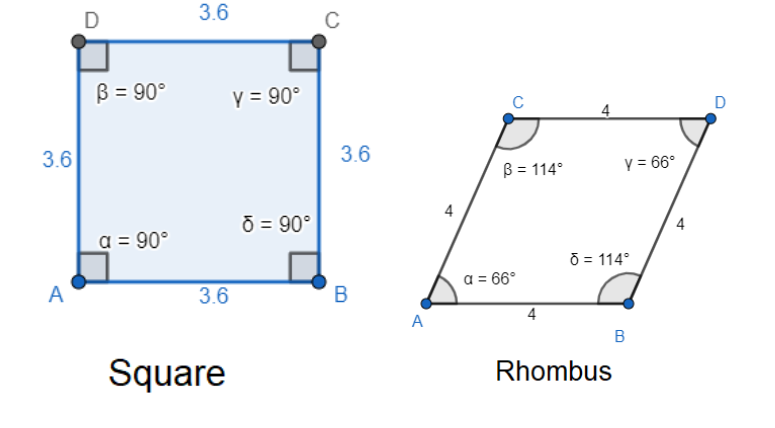
A ……….. has 4 sides equal and 4 right angles.
A. square
B. parallelogram
C. trapezium
D. rectangle
Answer
432k+ views
Hint: We first try to explain the concept of squares and rhombus. We also discuss the relation between them. We use that to find the concept of non-square rhombus with help of diagrams.
Complete step-by-step answer:
A parallelogram can be defined in the form of a quadrilateral which has its opposite sides parallel or equal or both. It has no particular condition of consecutive sides being congruent to each other. If the consecutive sides of parallelogram are equal then it becomes a particular form of parallelogram which is rhombus.
Since a square, a rhombus and a rectangle are also parallelograms, they are also excluded.

We have also rhombus which have all four sides equal and they have one angle being equal to
Now when we take a square, we can define it in the form of a rhombus where a rhombus converts into a square with its all angles being equal to each other. This means the angles of the square become equal to
So, the correct answer is “Option A”.
Note: Squares, rectangles and rhombus are all parts of a parallelogram. The main division of parallelograms is where the quadrilateral has equal or parallel opposite sides. Therefore, the specific figure of the square is also part of the rhombus.
Complete step-by-step answer:
A parallelogram can be defined in the form of a quadrilateral which has its opposite sides parallel or equal or both. It has no particular condition of consecutive sides being congruent to each other. If the consecutive sides of parallelogram are equal then it becomes a particular form of parallelogram which is rhombus.
Since a square, a rhombus and a rectangle are also parallelograms, they are also excluded.

We have also rhombus which have all four sides equal and they have one angle being equal to
Now when we take a square, we can define it in the form of a rhombus where a rhombus converts into a square with its all angles being equal to each other. This means the angles of the square become equal to
So, the correct answer is “Option A”.
Note: Squares, rectangles and rhombus are all parts of a parallelogram. The main division of parallelograms is where the quadrilateral has equal or parallel opposite sides. Therefore, the specific figure of the square is also part of the rhombus.
Recently Updated Pages
Master Class 4 Maths: Engaging Questions & Answers for Success

Master Class 4 English: Engaging Questions & Answers for Success

Master Class 4 Science: Engaging Questions & Answers for Success

Class 4 Question and Answer - Your Ultimate Solutions Guide

Master Class 11 Economics: Engaging Questions & Answers for Success

Master Class 11 Business Studies: Engaging Questions & Answers for Success

Trending doubts
In Indian rupees 1 trillion is equal to how many c class 8 maths CBSE

List some examples of Rabi and Kharif crops class 8 biology CBSE

How many ounces are in 500 mL class 8 maths CBSE

Summary of the poem Where the Mind is Without Fear class 8 english CBSE

Advantages and disadvantages of science

How many ten lakhs are in one crore-class-8-maths-CBSE





